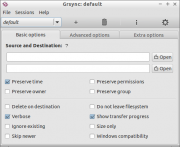

- Ubuntu grsync how to#
- Ubuntu grsync mac os#
- Ubuntu grsync full#
- Ubuntu grsync software#
Ubuntu grsync full#
First, it takes the full copy of the specified folder to the remote server. This combines two powerful backup concepts–mirroring and incremental backup. Rdiff-backup does remote incremental backup of your system effectively.
Ubuntu grsync how to#
How to exclude files and folders during rsync. The following three article will explain you everything you need to know about rsync: It is fast, secure, and uses less bandwidth. Backup location could be on local server or on remote server. Rsync utility is used to synchronize the files and directories from one location to another in an effective way. Rsync is a command line utility that is the basics of most of the GUI based backup tool mentioned here. The backups are really taken using the tar command and stored as. You can also take backup immediately using “Backup Now” feature. Ability to schedule the backup (this doesn’t use cron). For example, you can create a profile to backup all media files (mp3, videos, etc.), and another profile to backup data only. When it is not backing-up data, it runs in the background, and can be accessed from the icon in the system tray. The following are some of the features of backerupper: Apart from placing the backup on the system, you can also copy the backup to some other location on your local network.ĭo the following to get backerupper started. 
Backerupperīackerupper is a straight forward backup program that takes backup of the directories that you specify. Read more: How to Backup Ubuntu Desktop Using sbackup Simple Backup GNOME Tool 3.
Using the simple backup restoration wizard, you can pick any of the previous incremental or full backup, and do a restore either selectively or full. Purging: You can purge backups that are older than certain number of days from the system using this tab. If you are familiar with crontab, you can also specify the time in cron format. You can schedule both full and incremental backups. Schedule: Indicate how often you want to schedule the backup and when. This also provides the option to store the backup at a remote site using SSH or FTP. Destination: Specify where the backup needs to be stored. You can also exclude based on file types (for example: Exclude all *.mp3 from backup), regular expressions, and maximum file size. Exclude: Specify the list of folders or files that needs to be excluded from the backup. Include: Specify the list of folders or files that needs to be included in the backup. When you launch this software, it has the following tabs: Read more: Backup Your Files/Folders on Ubuntu Desktop using Pybackpack GUI Tool 2. 
Pybackpack - user friendly file backup tool for GNOME Restore: Select the backup location from where you like to restore, and the backupset name.From the backup tab, you can also launch the backupset editor, where you can specify the backupset name, description, the files and folders that needs to be included or excluded from the backup. You can also specify a remote server where the backup can be stored via SSH. Backup: Specify the backupset name, and the backup destination.This has a very simple and intutive user interface. Play around with these and pick the one that satisfies your need.
Ubuntu grsync software#
If you are using Ubuntu desktop, depending on your requirement, you can use any one of the following software to perform backup.
Can import and export sessions on file i.e.As you already know, it is very critical to take backup of your system on an on-going basis. Shell script for batch, crontab use etc. Can run custom commands before (and stop in case of failure) and after rsync. 
A good number of translations available.Highlights errors and show them on a separate window, for better and faster control over rsync runs.Parses rsync output to display progress bars and other information.Captures and prints rsync output nicely on a own window and log to a file.Saves multiple settings with customized names (no limit on number of "sessions").Most commonly used rsync options available, additional options may be specified by command line switches.Grsync is VERY easy to use: just choose the origin and destinations folders. Obviously, you can also use it with Ubuntu One or a network drive. For instance, since Dropbox does not have it's own back-up tool (that's why I really like SpiderOak for this job), you can use Grsync to syncronize some folders you want to back-up with your Dropbox folder. Rsync is the well-known and powerful command line directory and file synchronization tool.
Ubuntu grsync mac os#
Grsync is an open source rsync GUI (Graphical User Interface) which works on Windows, Linux and Mac OS X.







 0 kommentar(er)
0 kommentar(er)
